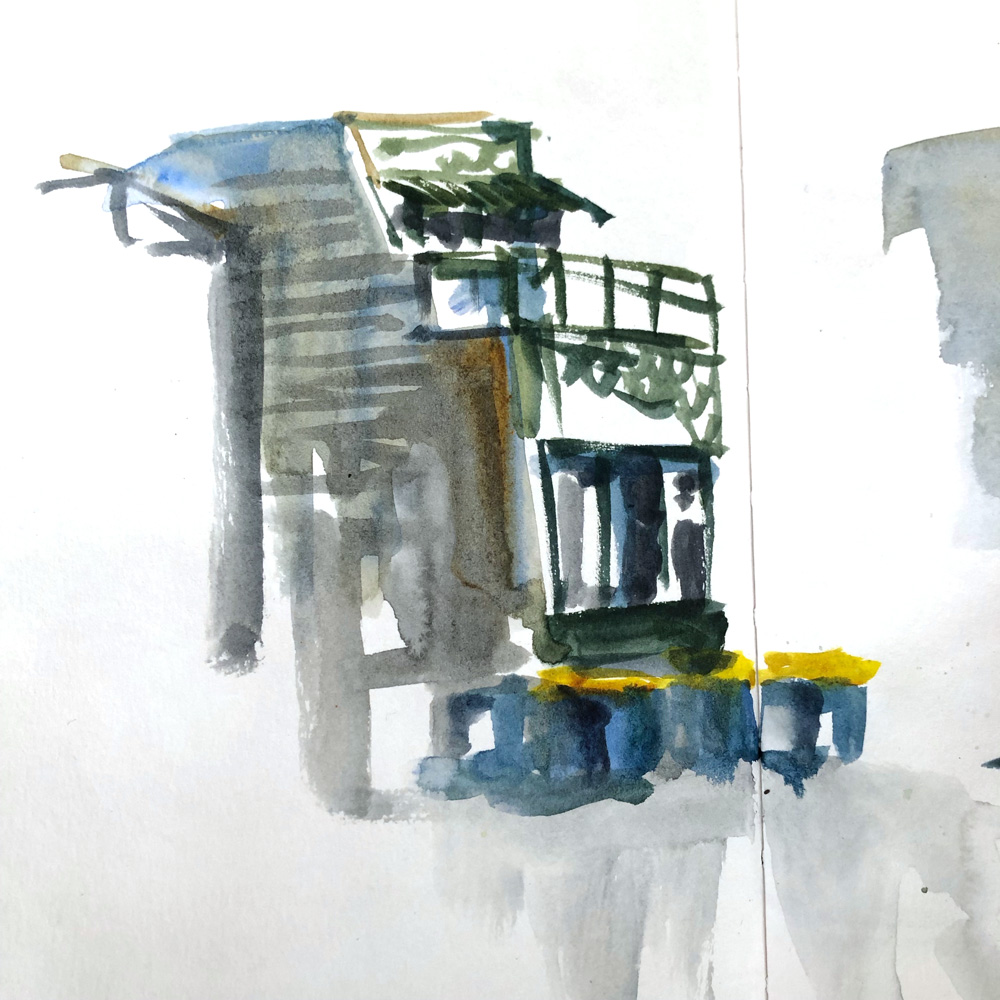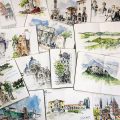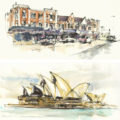 Here is a comparison between a waterbrush sketch and a ‘real’ brush sketch (done at a later date) of a very ordinary building in Turramurra.
Here is a comparison between a waterbrush sketch and a ‘real’ brush sketch (done at a later date) of a very ordinary building in Turramurra.

I just don’t know how to get good results from a waterbrush. Not only is the colour flat, but its just doesn’t have the control and the magic of using a normal brush!
 But having said that, having the option of using a waterbrush did mean that I actually got my paints out rather than doing a simple contour drawing in ink. So the convenience of a waterbrush is a significant characteristic – especially if it means I did a watercolour sketch.
But having said that, having the option of using a waterbrush did mean that I actually got my paints out rather than doing a simple contour drawing in ink. So the convenience of a waterbrush is a significant characteristic – especially if it means I did a watercolour sketch.
But on the other hand, doing this test reminds me that the very small extra effort to get brush and water container out is worth it every time! Just do it!
You can see another waterbrush vs real brush comparison here.
I would love to hear your thoughts on the subject!







18 Comments
Hi Liz,
When I added watercolour to my travel kit I had a waterbrush as it seemed the popular thing to do. I never produced anything I was happy with. It then took me trying a few different ‘real’ brushes to find one I enjoyed using and at least felt like there was potential. I don’t watercolour enough to have earned the right to anything like consistent success but there is the odd spark that makes me want to keep trying. One of my problems is I like using a variety of media so never master anything.
I also prefer using a normal brush to a watercolor brush, although I always have a waterbrush in my kit. I have made up an ultra-minimalist pocket kit that has only a petite waterbrush. Also, I keep a waterbrush with my watercolor pencils and use them for my water source there.
I prefer a regular brush as well. However, I have found a waterbrush I like very much for times when I do resort to a waterbrush. I don’t know if it’s OK to name brands here, but this one is the large size brush tip, and it’s very wet. That is what makes it so nice to use for a looser style. You can actually get juicy washes and in a larger area. If you want to use it more dry, you can wipe off some of the excess water in the bristles on a tissue. It’s the Holbein Large. Have you tried it?
I love the water brushes. They are great for small watercolor greeting cards or journals while sitting on the couch, where I would not want a cup of water to spill. Also great for travel journals. But I have found that different brands work differently. Some put out too much water. I tried several brands and found what I like. Also, the technique of using them is different, and required some practice. For larger paintings, regular brushes are definitely better.
I now use my waterbrush purely for watercolour pencils. When I am doing a long overseas trip I have found that I have limited time to sketch if I want to see everything, so I travel just with a few pens, watercolour pencils and a sketch book. I can add colour much more cleanly and quickly this way and there is little to carry.
Terrific post by the way! You take the time to give us real, proven answers to these eternal questions!
I don’t think of a waterbrush as a substitute for a traditional brush; I think of it as a different tool, so I don’t have the same expectations for it. If having a waterbrush means the difference between sketching and not sketching, then it has already earned its keep! 😉 And with watercolor pencils, I think it’s actually better than a traditional brush, which usually holds too much water and therefore washes out colored pencils.
I’m loving all the comments – thanks everyone for sharing.
I do need to a do another article about waterbrushes – sharing what they are good for! Because as a number of you have mentioned they are brilliant for some situations!
Just thought. I do use a waterbrush for small sketches with my fountain pens when I use water soluble ink. They are great for that.
I prefer to use a regular brush most of the time, but there are locations where the water brush is so convenient. It is useful when you just can’t take out a bottle of water. I was in NYC on Saturday at the Morgan Library. We were sketching in an elegant library and then in a historic studio. There was no way I could have used paint without the water brush.
Like most, I also prefer normal brushes, but when I’m out in the field and want to sketch in my nature journal, I like the convenience of the water brush – sometimes you don’t have the time or the third hand for you water jar. The only thing I don’t like is that you never get a dry brush effect, but that’s built in with the water brush..
Hi Liz. I actually prefer a waterbrush, and it has everything to do with convenience. I think it also has to do with how much time one spends with a particular tool. I’ve learned how to use them. I think the way the water is pushed out from behind the bristles for cleaning, as opposed to just swishing it around in water, cleans better. If I could make one suggestion that makes a world of difference, I would say, GO BIG! Use the largest brush size you can, you can get a lot of water and float a lot of pigment. No small water brushes allowed! Getting the right amount of water takes practice, but it can be done. I never have to take out extra cups, a water supply, or anything like that. It keeps my outdoor sketching kit very compact. Great Subject!!
I tried to love the water brush, but had already been using real brushes for a few years so the lack of control over the amount of water and difficulty getting water out of the brush to lift has been frustrating. I like the stiffness of the plastic brush of the water brush for details, but not for the big splashes of paint — and now that I have my Liz Steel-recommended Rosemary & Co sable travel brush, which flows across the page so deliciously, I don’t use the water brush much. I do keep it in my sketch bag in case there is no access to water, and use it sometimes on details.
Hello Liz,
I liked this post but I fear your deductions might be too hasty; though they are both tools for sketching, a waterbrush simply is not a regular brush (and I accurately avoid the term “real” here) but just a different kind of tool. A waterbrush, for instance, can hardly be forced to work dry but at the same time must be forced to be greedy in a way a regular brush often can be hardly held back. So, in this comparison, when you end up in using a sort of hatch to fill those large areas you normally do with a single wash you’re just using different techniques with different tools, not doing the same gestures just swapping tools. That, in the end, contributes to a different result.
I mean, you can’t have a decent haircut with shears though they’re actually scissors. Better, you can’t easily cut a hedge with scissors unless you have much time and some patience; it’s a hyperbole, sure, but it points out that a regular brush and a waterbrush are made for different styles of painting and sketching and you can’t easily compare them with a single sketch.
Moreover, in the last years your style has developed to a more loose approach, often doing withouth a pen or pencil sketch, which better suits large sketches and much paint; I – for example – sketch on A6 sized sketchbooks since my early times and I have a comic-style approach, so a regular brush is just too much for me because it’s paint greedy and it messes up my sketches.
It’s not just a matter of tools but a matter of tools-and-styles which we should actually compare, ain’t it?
Hi alessandro – thanks for sharing your thoughts! And I agreed that the waterbrush is great for some things.. The main point I wanted to make in this article is that is not good FOR ME as a substitute for a real brush. In fact it is so useful for other reasons that it goes in my minimal kit! Sorry if my comments didnt read that way!! I will be doing a part 2 🙂
Hello Liz,
I understand you write about your own impressions but if I read “doing this test reminds me that the very small extra effort to get brush and water container out is worth it every time! Just do it!” I think of it as an advice to sketchers; that’s why I wanted to point out a few things. The inexperienced sketcher might take the words of a professional sketcher very seriously – and maybe give up just because the drag of a regular brush and a water container are not exactly what he had in mind when thinking about portability.
You’re not wrong at all, Liz 🙂 Just a bit too brief to let readers learn; after all also brushes aren’t all alike; you’d be in trouble with your everyday dagger brush if you had to paint on an A0 sized sheet (and I would too!).
Now I’m waiting for part two. Just do it 😉
There is definitely a learning curve on the waterbrush….. but the more you use it, the more indistinguishable your sketches will be [from *regular* brushes]….. for example, sometimes you need to pay more attention to pre-wetting the page or area… then make sure you have enough color mixed up/ready, so you can get those nice big areas of color moving across water. It does behave a little differently, and it takes time to master it! xo
I use both brush for A$ or larger and 2 sizes of waterbrush for A5 . Is all how you use it without adding extra water to the pan the colour is rich and deep, on the contrary pressing to add water result in weak colour A combination of both helps to blend colours directly on the paper adding moisture to the paper just before helps to spread the colours
NEWSLETTER
Subscribe for first notification of workshop + online classes and more.